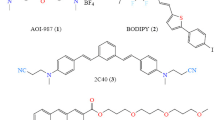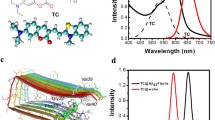Abstract
Detection of amyloid-β (Aβ) aggregates in the brain is essential for an early diagnosis and for tracing the evolution of Alzheimer’s disease. Positron emission tomography is the most commonly used technique for Aβ detection, but fluorescence imaging is a promising alternative. For their in vivo application, fluorescent Aβ markers should emit in the near-infrared region and present strong binding affinities for Aβ aggregates. The dithiophene-based NIAD-4 dye and its derivatives NIAD-11 and NIAD-16 are within the most interesting Aβ markers as they fulfill these two criteria. In this contribution, the photophysical properties of these compounds as well as their binding to amyloid-β fibrils have been studied with a combination of computational techniques (TDDFT and MS-CASPT2 calculations, AIMD simulations and fit-induced docking calculations). Modifications on the NIAD-4 skeleton have little effects on the ground and excited state properties of the dye as well as on the feasibility of the most probable non-radiative deactivation pathways. However, they tune the absorption and emission wavelengths and affect significantly the blood–brain barrier (BBB) permeability and binding site preference toward Aβ fibrils. A red-shifting of the emission wavelength is achieved by enlarging the π-system in NIAD-11 and by increasing the charge transfer in NIAD-16, the effect of the former being significantly larger in gas phase. However, the larger solvatochromic effect observed for NIAD-16 leads to similar emission wavelengths in water solution for the two dyes. Overall, the variation of the charge transfer extent of the transition seems to be more appropriate at least in this case, since it has a smaller effect on the BBB permeability and binding site preference of the new dye with respect to the original NIAD-4.






Similar content being viewed by others
References
Querfurth HW, Laferla FM (2010) N Engl J Med 362:329–344
LaFerla FM, Green KN (2012) Cold Spring Harb Perspect Med 2:1–13
Petkova AT, Yau W-M, Tycko R (2006) Biochemistry 45:498–512
Lu J-X, Qiang W, Yau W-M et al (2013) Cell 154:1257–1268
Tycko R (2011) Annu Rev Phys Chem 62:279–299
Lührs T, Ritter C, Adrian M et al (2005) Proc Natl Acad Sci USA 102:17342–17347
Ntziachristos V (2006) Annu Rev 8:1–33
Staderini M, Martín MA, Bolognesi ML, Menéndez JC (2015) Chem Soc Rev 44:1807–1819
Nesterov EE, Skoch J, Hyman BT et al (2005) Angew Chem Int Ed 44:5452–5456
Peccati F, Hernando J, Blancafort L et al (2015) Phys Chem Chem Phys 17:19718–19725
Raymond SB, Skoch J, Hills ID et al (2008) Eur J Nucl Med Mol Imaging 35:93–98
Frisch MJ, Trucks GW, Schlegel HB et al (2009) Gaussian 09. Gaussian Inc, Wallingford, CT
Yanai T, Tew DP, Handy NC (2008) Chem Phys Lett 393:51–57
Ditchfield R, Hehre WJ, Pople JA (1971) J Chem Phys 54:724–728
Adamo C, Jacquemin D (2013) Chem Soc Rev 42:845–856
Peccati F, Wiśniewska M, Solans-Monfort X, Sodupe M (2016) Phys Chem Chem Phys 18:11634–11643
Marenich AV, Cramer CJ, Truhlar DG (2009) J Phys Chem B 113:6378–6396
Scalmani G, Frisch MJ, Mennucci B et al (2006) J Chem Phys 124:094107
Le Bahers T, Adamo C, Ciofini I (2011) J Chem Theory Comput 7:2498–2506
Ciofini I, Le Bahers T, Adamo C et al (2012) J Phys Chem C 116:11946–11955
Peach MJG, Williamson MJ, Tozer DJ (2011) J Chem Theory Comput 7:3578–3585
Aquilante F, Pedersen TB, Veryazov V, Lindh R (2013) Wiley Interdiscip Rev Comput Mol Sci 3:143–149
Pou-Amérigo R, Merchán M, Nebot-Gil I et al (1995) Theor Chim Acta 92:149–181
Ghigo G, Roos BO, Malmqvist PÅ (2004) Chem Phys Lett 396:142–149
Huix-Rotllant M, Filatov M, Gozem S et al (2013) J Chem Theory Comput 9:3917–3932
VandeVondele J, Krack M, Mohamed F et al (2005) Comput Phys Commun 167:103–128
Perdew J, Burke K, Ernzerhof M (1996) Phys Rev Lett 77:3865–3868
Grimme S (2006) J Comput Chem 27:1787–1799
Hartwigsen C, Goedecker S, Hutter J (1998) Phys Rev B 58:3641–3662
Goedecker S, Teter M, Hutter J (1996) Phys Rev B 54:1703–1710
VandeVondele J, Hutter J (2007) J Chem Phys 127:114105
Madadkar-Sobhani A, Guallar V (2013) Nucleic Acids Res. doi:10.1093/nar/gkt454
Clark DE, Pickett SD (2000) Drug Discov Today 5:49–58
Abraham MH, Takács-Novák K, Mitchell RC (1997) J Pharm Sci 86:310–315
Nadal-Ferret M, Gelabert R, Moreno M, Lluch JM (2013) J Chem Theory Comput 9:1731–1742
Sanchez-Garcia E, Doerr M, Thiel W (2009) J Comput Chem 31:1603–1612
Imhof P (2012) J Chem Theory Comput 8:4828–4836
Isborn CM, Götz AW, Clark MA et al (2012) J Chem Theory Comput 8:5092–5106
De Mitri N, Monti S, Prampolini G, Barone V (2013) J Chem Theory Comput 9:4507–4516
Stsiapura VI, Maskevich A, Kuzmitsky V et al (2008) J Phys Chem B 112:15893–15902
Beljonne D, Shuai Z, Pourtois G, Bredas JL (2001) J Phys Chem A 105:3899–3907
Molnar F, Ben-Nun M, Martínez TJ, Schulten K (2000) J Mol Struct 506:169–178
Valsson O, Filippi C (2010) J Chem Theory Comput 6:1275–1292
Levine BG, Ko C, Quenneville J, MartÍnez TJ (2006) Mol Phys 104:1039–1051
Tycko R, Wickner RB (2013) Acc Chem Res 46:1487–1496
Borrelli KW, Vitalis A, Alcantara R, Guallar V (2005) J Chem Theory Comput 1:1304–1311
Acknowledgments
The authors gratefully acknowledge financial support from MINECO (projects CTQ2014-59544-P) and the Generalitat de Catalunya (projects and 2014SGR-482). MS acknowledges the Generalitat de Catalunya for the 2011 ICREA Academia award and XSM for a Professor Agregat Serra Húnter position.
Author information
Authors and Affiliations
Corresponding authors
Additional information
Published as part of the special collection of articles “Charge Transfer Modeling in Chemistry”.
Electronic supplementary material
Below is the link to the electronic supplementary material.
Rights and permissions
About this article
Cite this article
Peccati, F., Solans-Monfort, X. & Sodupe, M. The role of charge transfer in the photophysics of dithiophene-based (NIADs) fluorescent markers for amyloid-β detection. Theor Chem Acc 135, 184 (2016). https://doi.org/10.1007/s00214-016-1934-5
Received:
Accepted:
Published:
DOI: https://doi.org/10.1007/s00214-016-1934-5




